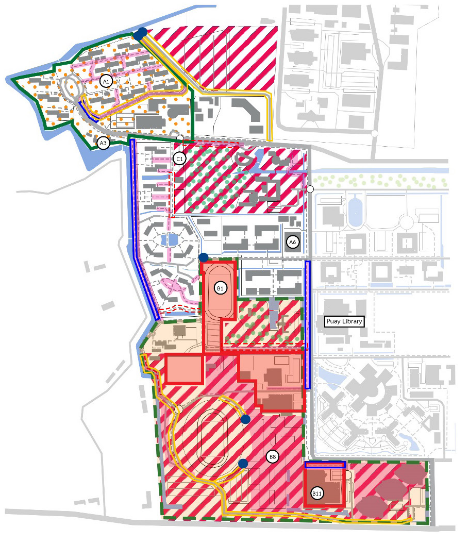Crime Prevention through Environmental Design: A Case Study of Thammasat University Rangsit Campus
Main Article Content
Abstract
Crime is considered as one of the major social problems in Thailand that causes huge impacts to society. In order for a crime to occur, three elements must coincide; desire, ability, and opportunity. Therefore, crime prevention method can be done by reducing crime opportunity as other factors; desire and ability cannot be controlled by an external party. According to the Royal Thai Police (2019), the demographic data indicated that Pathum Thani is the second most unsafe district in the Bangkok and Metropolitan Region (BMR) after Bangkok. The researcher, therefore, chose a part of Thammasat University Rangsit campus which consists of a residential, recreational and commercial zone as the study area for this research.
Mapping and overlay analysis are used as an analytical tool to identify an unsafe location. Analytic Hierarchy Process (AHP) is used to identify both physical and non-physical attributes associated with such unsafe locations. The results of the analysis illustrate that the area at the back of the main stadium is the most unsafe place when considering physical and non-physical attributes. On the other hands, considering user’s experiences, the area around Laan Payanak are seen to be the most unsafe place as well as is known of being a crime location. According to our survey, the correspondents strongly agree that lighting illumination on pedestrian walkway contributes to their feeling of fear for crime the most. The result from the AHP also shows that users choose the lighting issue as the first priority as well.
Recommendations for urban design guideline for crime prevention include (1) changing the pedestrian lights to allow better lighting and visibility of the users (2) encouraging more activities on the area of Laan Payanak to crowd the area, giving more security to people in the area (3) providing gate, operation time sign at every entrance to control the accessibility of each area and route, and (4) providing emergency equipment and information for self-help or calling for help.
Downloads
Article Details

This work is licensed under a Creative Commons Attribution-NonCommercial-NoDerivatives 4.0 International License.
All material is licensed under the terms of the Creative Commons Attribution 4.0 International (CC-BY-NC-ND 4.0) License, unless otherwise stated. As such, authors are free to share, copy, and redistribute the material in any medium or format. The authors must give appropriate credit, provide a link to the license, and indicate if changes were made. The authors may do so in any reasonable manner, but not in any way that suggests the licensor endorses you or your use. The authors may not use the material for commercial purposes. If the authors remix, transform, or build upon the material, they may not distribute the modified material, unless permission is obtained from JARS. Final, accepted versions of the paper may be posted on third party repositories, provided appropriate acknowledgement to the original source is clearly noted.
References
Center of Innovative Design and Research. (2014). Final Report of Thammasat University Rangsit campus 2034 (online). Department of planning and quality development, Thammasat University. Retrieved from https://planning.tu.ac.th/uploads/planning/pdf/Place/07092561/Re20180819_2.pdf
Chubumrung, A. (1984). Criminology. Criminological Theory. Bangkok: O.S. printing House Co., Ltd.
Civilian Security Organization. (2016). The definitions of crime. Civilian Security Organization. Retrieved from https://www.secnia.go.th/2016/01/13/%E0%B8%84%E0%B8%A7%E0%B8%B2%E0%B8%A1%E0%B8%AB%E0%B8%A1%E0%B8%B2%E0%B8%A2%E0%B8%82%E0%B8%AD%E0%B8%87%E0%B8%AD%E0%B8%B2%E0%B8%8A%E0%B8%8D%E0%B8%B2%E0%B8%81%E0%B8%A3%E0%B8%A3%E0%B8%A1/
League of Liberal Thammasat for Democracy (LLTD). (2016). Crime locations within the campus and surrounding. Retrieved from https://web.facebook.com/LLTD.TU/photos/a.621001327921846/1286451928043446/?type=3&theater
National Crime Prevention Council of Singapore. (2003). Crime Prevention through Environmental Design Guidebook (Online). National Crime Prevention Council of Singapore. Retrieved from http://www.popcenter.org/tools/cpted/PDFs/NCPC.pdf
Pinijsak, S. (1983). Alternative: Acception of the Personnels in Criminology’s Roles in the Metropolitan Police Bureau (Master’s Thesis). Faculty of Social Sciences and Humanities, Mahidol University.
Royal Thai Police. (2019). The demographic of crimes in Thailand. Central Information Technology centre. Retrieved from http://pitc.police.go.th/dirlist/dirlist.php?dir=/crimes
The Leading Authority for Campus Public Safety. (n.d.). What is crime prevention?. International Association of Campus Law Enforcement Administrators. Retrieved from https://www.iaclea.org/what-is-crime-prevention


